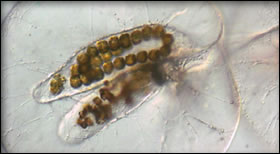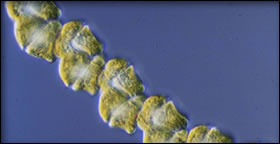 The Scientist: The Scientist:
Paul Armstrong BAppSc(Hons)
School of Aquaculture, University of Tasmania
Paul’s youth was spent in Launceston, and in grade five, his dad presented him with his first fish tank.
“I kept heaps of fish as a kid,” he says.
It is therefore not surprising to find that Paul has ended up linking his scientific interests to the aquaculture industry. He is two years into his PhD looking at the links between nutrients and phytoplankton blooms in the Huon estuary – particularly around aquaculture areas. The Huon Estuary is the major area for salmon farming in Tasmania. The main aim of his project is determine which types of nitrogen are most important for phytoplankton blooms in the Huon Estuary. One of the specific aims of his project is to investigate the nitrogen uptake capabilities and strategies of Gymnodinium catenatum – a toxic dinoflagellate species that has bloomed in the estuary in recent years. His PhD is being done through the School of Aquaculture in Launceston, and CSIRO Marine Research in Hobart. Paul finds the environmental aspects of science particularly interesting, and believes his outdoor interests – he is a keen bushwalker, surfer and snorkeller – have led him to working in science. “I think it is important to understand and maintain our environment, and especially understand how what we do impacts the environment,” he says. Paul particularly enjoys the field work involved in the science he does. “I like to get out there and see what is going on,” he says. Paul has always had an interest in aquaculture and in 2001 he completed his honours on seahorse genetics at the School of Aquaculture in Launceston. He says he would like to focus his future efforts on working with the aquaculture industry in helping it manage the impacts that it has on the environment and as a result of this, become a more sustainable industry. Paul finds the challenges of working in science, the variety of things he is able to do, and the problem solving nature of his work enjoyable. He spends time in the laboratory, has recently just finished his field work and is now in the process of writing chapters of his thesis. More about the Work Key Words: Phytoplankton, Gymnodinium catenatum, algal blooms, nitrogen uptake The Huon Estuary is the major area for salmon farming in Tasmania. The recent Huon Estuary study identified several key areas that required further understanding if the estuary was to be more effectively managed. One of the key areas was the link between nutrients and phytoplankton blooms in the estuary. The Huon Estuary study suggests that phytoplankton growth is limited primarily by nitrogen. The main objective of this project is to determine which nitrogen sources: nitrate (NO3), ammonia (NH4) and urea are important for supporting phytoplankton growth in the Huon Estuary. A more specific aim within this project is to investigate the nitrogen uptake capabilities and strategies of one the main dinoflagellate species Gymnodinium catenatum that has bloomed in the estuary in recent years. Paul says ”We are specifically looking at G. catenatum for several reasons. It is still not known why it blooms in some years and not others and when it does why it blooms at far higher biomasses than any other species recorded in the Huon to date. Studying G. catenatum will also help us understand the bloom dynamics of other dinoflagellate species that cause problems in the Huon Estuary (such as Noctiluca scintillans).” N. scintillans also causes red tides, blooms of this species have dramatically increased in frequency and duration in southeastern Australian coast waters since the early 1990s.

Gymnodinium

Gymnodinium

Gymnodinium
Websites: Huon Estuary Study
https://www.marine.csiro.au/research/sme/huonest/summary.html Algal Bloom Dynamics
https://www.nwfsc.noaa.gov/hab/HABs_Toxins/Phytoplankton/AlgalDynamics.htm What are Harmful Algal Blooms?
https://www.whoi.edu/redtide/whathabs/whathabs.html School of Aquaculture, University of Tasmania
https://www.utas.edu.au/aqua |
